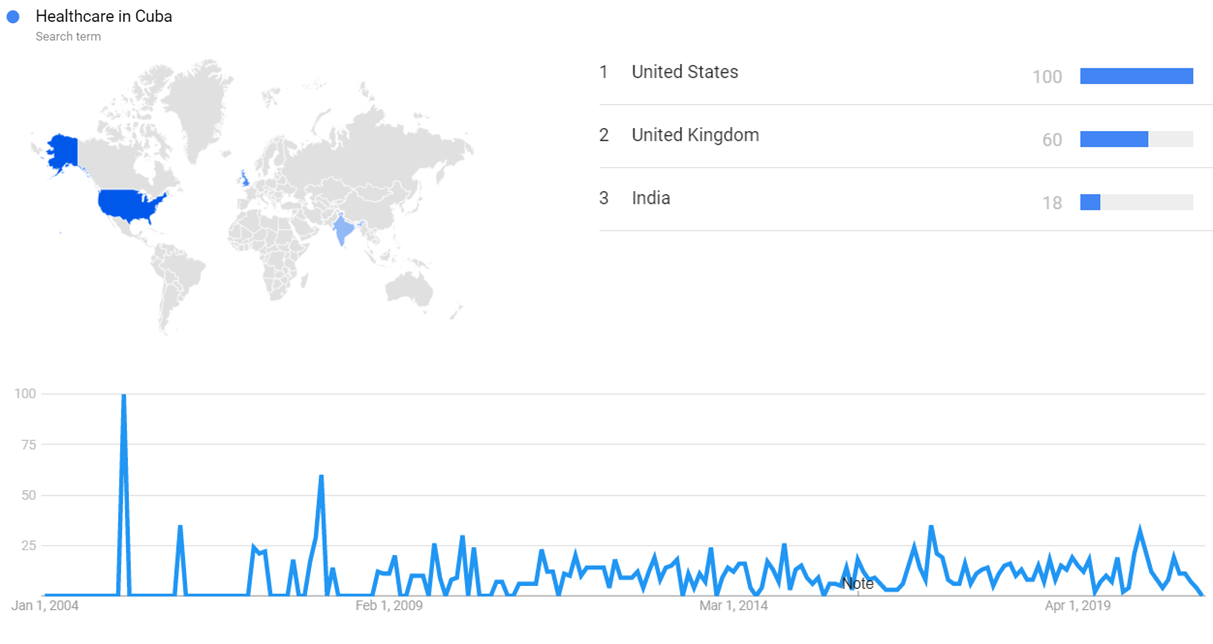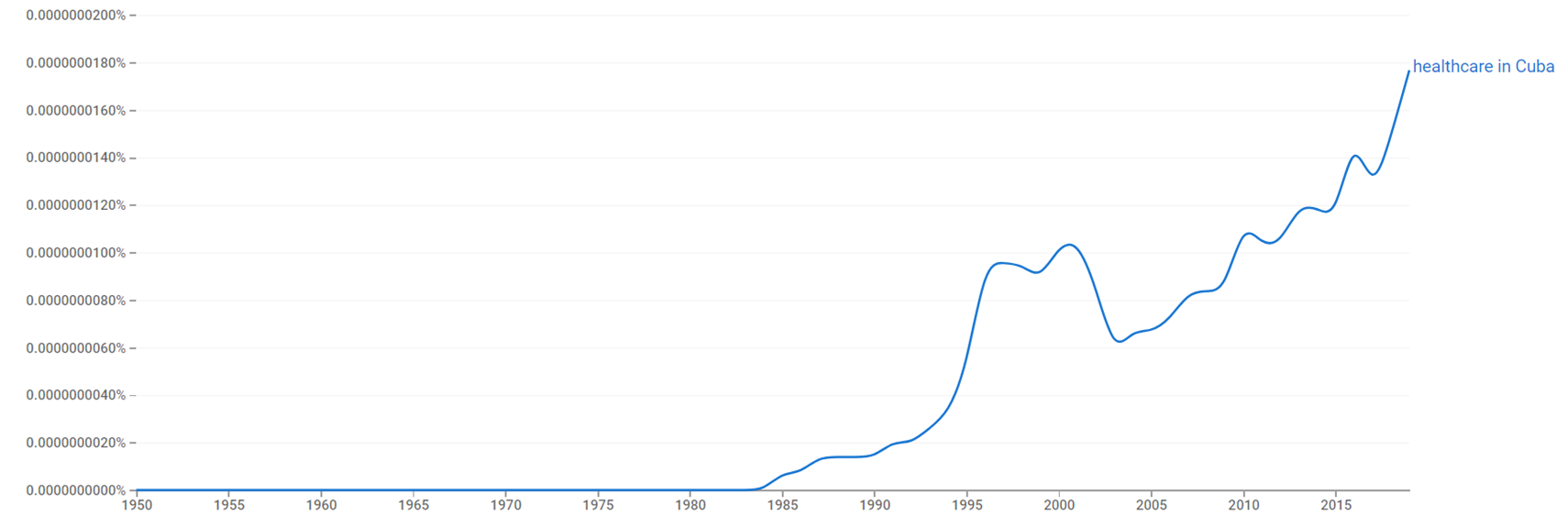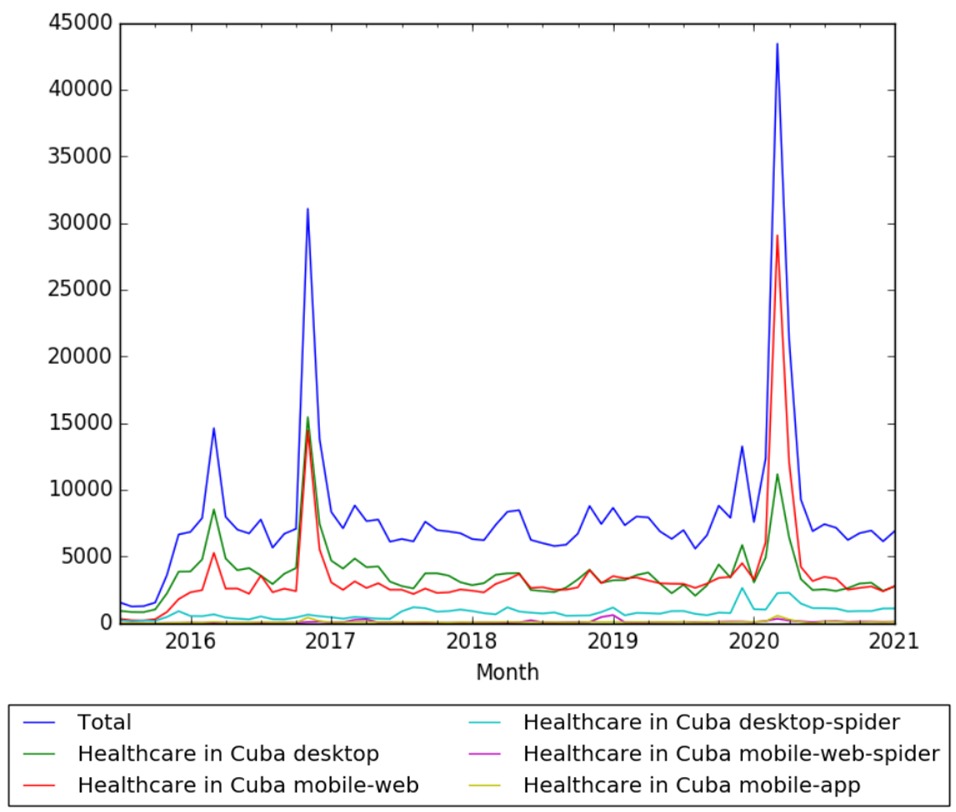Timeline of healthcare in Cuba
From Timelines
The content on this page is forked from the English Wikipedia page entitled "Timeline of healthcare in Cuba". The original page still exists at Timeline of healthcare in Cuba. The original content was released under the Creative Commons Attribution/Share-Alike License (CC-BY-SA), so this page inherits this license.
This is a timeline of healthcare in Cuba, focusing on the modern state. Some international campaigns outside of local healthcare are also described.
Contents
Big picture
| Year/period | Key developments |
|---|---|
| Prior to 1960 | Pre-Revolution era. Health services and facilities are concentrated in the cities.[1] Provision of medical supplies is heavily dependent on imports from other countries, mostly the U.S. Private sector healthcare is primarily for the wealthy. A poorly funded and staffed public sector responds for the rest of the population.[2] |
| 1960s | Soon after the revolution, universal healthcare is adopted and becomes a priority of state planning. U.S. government imposes embargo against Cuba, which would lead to an increase in disease and infant mortality during this decade.[3] Approximately half the physicians in Cuba emigrate.[4] |
| 1970s | The polyclinic model of primary care is reinforced and expanded, focusing on health education, prevention and environmental monitoring. The number of medical graduates increase, thus enlarging the Cuban medical internationalism program.[4] |
| 1980s | Cuban healthcare system consolidates. Primary care is given impetus with the introduction of the Family Doctor-and-Nurse Program. Biotechnology industry takes off.[4] |
| 1990s | Post Soviet era, starts with Cuba's Special Period of socioeconomic collapse, due to loss of funding from the dissolved U.S.S.R. Cuba starts to accept U.S. donations of food, medicines and cash. At the same time, U.S. embargo tightens.[5] Infectious diseases rise while infant mortality continues to decline.[4] |
| 2000s–present | Cuba's health indices rank extraordinarily at a developed country level, considering that Cuba is a country of poor resources and economic underdevelopment. Cuba also boasts one of the highest physician-per-inhabitant ratios in the world, though massive deployment of doctors on foreign missions can leave gaps in the country's domestic primary healthcare programs.[6] Medical tourism is also a thriving and growing industry today in Cuba.[7] So far, it is widely believed that medical workers are Cuba's most important export commodity.[8] Cuba also successfully exports many medical products, such as vaccines.[9] |
Visual data
Google Trends
The image below shows Google Trends data for Healthcare in Cuba (Search term) from January 2004 to February 2021, when the screenshot was taken. Interest is also ranked by country and displayed on world map.[10]
Google Ngram Viewer
The chart below shows Google Ngram Viewer data for Healthcare in Cuba from 1950 to 2019.[11]
Wikipedia Views
The chart below shows pageviews of the English Wikipedia article Healthcare in Cuba on desktop, on mobile-web, desktop-spider,mobile-web-spider and mobile app, from July 2015; to January 2021.[12]
Full timeline
| Year/period | Type of event | Event | Location |
|---|---|---|---|
| 1881 | Discovery | Cuban epidemiologist Carlos Finlay provides evidence that mosquito Aedes aegypti transmits disease to and from humans.[13] | |
| 1898–1902 | Achievement | Yellow fever is virtually eradicated due to the efforts of Clara Maass and surgeon Jesse William Lazear during this period of U.S. presence.[14] | |
| 1950–1955 | Report | Infant mortality rate levels at 80.69 deaths per 1,000 live births, a figure higher than those of Paraguay and Surinam.[15] | |
| 1959 | Political change | End of Cuban revolution and establishment of the socialist state and communist government. Fidel Castro takes office. | |
| 1960 | Publication | Revolutionary and physician Ernesto "Che" Guevara writes crucial essay entitled On Revolutionary Medicine, outlining the future of Cuban healthcare.[16] | |
| 1960 | Policy | The Ministry of Public Health begins a program of nationalization and regionalization of medical services.[17] First U.S. embargo against Cuba.[18] | |
| 1961 | Organization (campaign) | Cuba starts to deploy physicians to work in poor countries around the world, starting with medical brigades to assist during the Algerian War.[19][20] | |
| 1962 | Policy | "Vaccination days" are established with the goal of reaching the entire population. Proving later to be effective in eliminating polio, it is subsequently adopted in other countries as a primary strategy.[21] | |
| 1963 | Policy (Campaign) | The Cuban medical internationalism program is initiated. | |
| 1963 | Foreign policy | U.S. embargo against Cuba prohibits trade in food, medicines, and medical supplies.[19] | |
| 1963 | Achievement | Cuba declares free of polio.[22] | |
| 1965 | Policy | Cuban government creates a system of community-based polyclinics, with aims at providing primary-care, specialty services, and laboratory and diagnostic testing to a catchment area of 25,000 to 30,000 people.[19] | |
| 1969 | Organization (research institute) | Cuban Neuroscience Center (CNEURO) founded.[23] | Havana |
| 1970 | Development | First Kidney transplant is performed in Cuba.[24] | Havana (Nephrology Institute) |
| 1970 | Policy | The Maternal–Child Programme (Programa Nacional de Atencion Materno-Infantil—PAMI) is launched with the purpose of assuring the health of women of child-bearing age and their children.[21] | |
| 1972 | Organization (alliance) | Cuba becomes a full member of the Soviet-based Council for Mutual Economic Assistance (COMECON).[25] | |
| 1972 | Achievement | Cuba declares free of neonatal tetanus.[21] | |
| 1976 | Policy | Fidel Castro elected president. Cuban constitution revision. Article 50: Everyone has the right to health protection and care. The state guarantees this right by providing free medical and hospital care by means of the installations of the rural medical service network, polyclinics, hospitals, preventative and specialized treatment centers; by providing free dental care; by promoting the health publicity campaigns, health education, regular medical examinations, general vaccinations and other measures to prevent the outbreak of disease. All the population cooperates in these activities and plans through the social and mass organizations.[26] |
|
| 1979 | Achievement | Cuba declares free of diphteria.[21] | |
| 1979 | Organization (medical school) | University of Medical Sciences, Cienfuegos is founded.[27] | Cienfuegos |
| 1982 | Organization (hospital) | Hermanos Ameijeiras Hospital (HDCQHA) is founded.[28] | Havana |
| 1984 | Policy | A Family Doctor-and-Nurse Program is launched, by which neighborhood/home clinic model is adopted. The physician and the nurse must live in the neighborhood they're serving. They're also expected to conduct research and present their findings at congresses or in journals.[4][29] | |
| 1985 | Development | First heart transplant is performed in Cuba.[24] | Havana (HDCQHA) |
| 1985–1990 | Report | Infant mortality rate levels at 13.01 deaths per 1,000 live births, the lowest in Latin America.[15] | |
| 1986 | Development | First heart-lung transplant is performed in Cuba.[24] | Havana (HDCQHA) |
| 1986 | Development | First liver transplant is performed in Cuba.[24] | Havana (HDCQHA) |
| 1986 | Development | First pancreas-kidney transplant is performed in Cuba.[24] | Havana (Nephrology Institute) |
| 1989 | Development | First lung transplant is performed in Cuba.[24] | Havana |
| 1990 | Development | First heart-lung transplant is performed in Cuba.[24] | Havana (HDCQHA) |
| 1991 | Crisis | Collapse of Soviet Union and beginning of the so-called Special Period. Soviet funding halts, depriving Cuba from almost all foreign commodities, including pharmaceuticals. An epidemic of optical and peripheral neuropathy, subsequently traced to a sharp decline in protein, vitamins, and some other micronutrients, afflicts at least 50 000 Cubans. Also a modest increase in mortality from infectious diseases, particularly tuberculosis, is observed.[21] | |
| 1992 | Foreign policy/crisis | U.S. “Torricelli Bill” tightens embargo against Cuba, thus deepening the severe material shortages and affecting medical care. The number of foreign-based subsidiaries of U.S. companies granted licenses to sell medicines to Cuba start to decline dramatically.[19][30] | |
| 1993 | Achievement | Cuba declares free of measles.[21] | |
| 1994 | Achievement | Cuba declares free of pertussis.[21] | |
| 1994 | Organization (medical school) | Facultad de Ciencias Medicas Sancti Spiritus is founded.[31] | Sancti Spiritus |
| 1994 | Organization (Research institute) | Center of Molecular Immunology (Centro de Inmunología Molecular) or CIM is founded.[32] | Havana |
| 1995 | Achievement | Cuba declares free of rubella and mumps.[21] | |
| 1999 | Organization (medical school) | ELAM (Latin American School of Medicine) is founded.[33] | Havana |
| 2000 | Kofi Annan: "Cuba's achievements in social development are impressive given the size of its gross domestic product per capita. As the human development index of the United Nations makes clear year after year, Cuba should be the envy of many other nations, ostensibly far richer. Cuba demonstrates how much nations can do with the resources they have if they focus on the right priorities - health, education, and literacy."[34] | ||
| 2002 | Report | Cuba attains the second lowest infant mortality in the Americas, 20% below the U.S. rate for all ethnic groups and also below the rate for white Americans.[21] | |
| 2004 | Organization (program launch) | Operation Miracle is initiated by Cuba jointly with Venezuela, in which medical workers from both countries would perform surgeries for cataracts, glaucoma, and other eye ailments, with the goal of reaching six million operations across the Americas by 2015.[35] | |
| 2005 | Development | First pediatric liver transplant is performed in Cuba.[24] | Havana (HDCQHA) |
| 2005 | Organization (campaign) | Cuba offers to send 1500 medics to New Orleans in response to Hurricane Katrina. Such aid is rejected by the U.S. government.[36][37] | |
| 2006 | Policy | The Cuban government spends about $355 per capita on health, 7.1% of total Gross Domestic Product (GDP).[19] | |
| 2011 | Achievement | Cuba announces release of the world's first lung cancer vaccine.[38] | |
| 2012 | Development | First Latin American catheter ablation registry established.[39] | |
| 2015 | Achievement | Cuba becomes the first country to eradicate mother-to-child transmission of HIV and syphilis.[40] |
See also
References
- ↑ C. William Keck, Gail A. Reed (2012). "The Curious Case of Cuba". Am J Public Health. 102: e13–22. PMC 3464859
 . PMID 22698011. doi:10.2105/AJPH.2012.300822.
. PMID 22698011. doi:10.2105/AJPH.2012.300822.
- ↑ Primary Health Care in Cuba, The Other Revolution, by Linda M. Whiteford and Laurence G. Branch
- ↑ Dominguez, Jorge (1993), "Cuba since 1959", in Bethell, Leslie (ed., 1993), Cuba: a short history, Cambridge: Cambridge University Press
- ↑ 4.0 4.1 4.2 4.3 4.4 "Cuban healthcare in the nineties" (PDF).
- ↑ "Health consequences of Cuba's Special Period". Canadian Medical Association Journal.
- ↑ "Health and Health Care: Revolutionary Period (Cuba)".
- ↑ Commentary: A Novel Tourism Concept Caribbean Net News
- ↑ Foreign Affairs July/August 2010. page 69
- ↑ Cuba sells its medical expertise BBC News
- ↑ "Healthcare in Cuba". Google Trends. Retrieved 25 February 2021.
- ↑ "Healthcare in Cuba". books.google.com. Retrieved 25 February 2021.
- ↑ "Healthcare in Cuba". wikipediaviews.org. Retrieved 24 February 2021.
- ↑ Finlay CJ. (1881). "El mosquito hipotéticamente considerado como agente de transmision de la fiebre amarilla". Anales de la Real Academia de Ciencias Médicas Físicas y Naturales de la Habana (18): 147–169.
- ↑ The Philip S. Hench Walter Reed Yellow Fever On-line Collection [02954005]&query=james+carroll Online
- ↑ 15.0 15.1 United Nations World Population Prospects: the 2015 Revision - an XLS file
- ↑ On Revolutionary Medicine by Che Guevara Monthly review
- ↑ Cuban Healthcare: An analysis of a Community-based model Essam Farag online
- ↑ The impact of the economic crisis and the US embargo on health in Cuba. American journal of public health. 1997 January. Accessed 6 October 2006.
- ↑ 19.0 19.1 19.2 19.3 19.4 Paul K. Drain, Michele Barry (2010). "50 Years of U.S. Embargo: Cuba's Health Consequences and Lessons". Science. 328: 572–3. PMC 3990013
 . PMID 20430999. doi:10.1126/science.1189680.
. PMID 20430999. doi:10.1126/science.1189680.
- ↑ Gleijeses, Piero (1996). "Cuba's First Venture in Africa: Algeria, 1961-1965". Journal of Latin American Studies. 28 (1): 159–195. JSTOR 157991. doi:10.1017/s0022216x00012670.
The Minister of Public Health, Jose Ramón Machado Ventura, led the group, which included 29 doctors, three dentists, 15 nurses and eight medical technicians. (There were 45 men and ten women.) . . . With the arrival of this medical mission in Algeria on 24 May 1963, Cuba's technical assistance abroad began.
(Quote is from p. 165). - ↑ 21.0 21.1 21.2 21.3 21.4 21.5 21.6 21.7 21.8 Richard S Cooper1, Joan F Kennell, and Pedro Orduñez-Garcia. "Health in Cuba". Oxford Journals.
- ↑ "Randomized, Placebo-Controlled Trial of Inactivated Poliovirus Vaccine in Cuba".
- ↑ "Cuba, Russia and Neurosciences".
- ↑ 24.0 24.1 24.2 24.3 24.4 24.5 24.6 24.7 "Organ Donation & Transplants in Cuba: Promising Results, Challenges Ahead".
- ↑ "Cuba profile - Timeline".
- ↑ ° English translation of the 1976 Constitution of Cuba Wikisource. 1976 Constitution of Cuba 1976 (in Spanish)
- ↑ Universidad de Ciencias Médicas de Cienfuegos
- ↑ "Hospital Hermanos Almejeiras", EcuRed (Cuban state wiki)
- ↑ Swanson KA, Swanson JM, Gill AE, Walter C. (1995). "Primary care in Cuba: a public health approach.". Health Care Women Int. PubMed. 16: 299–308. PMID 7649887. doi:10.1080/07399339509516183.
- ↑ Whiteford, Linda M.; Manderson, Lenore, eds. (2000). Global Health Policy, Local Realities: The Fallacy of the Level Playing Field. Boulder, Col.: Lynne Rienner Publishers. p. 69. ISBN 1-55587-874-1. Retrieved September 14, 2009.
- ↑ Cuban Ministry, Higher Education. "Facultad ciencias Medicas in Cuba". Cuban Education Ministry. Government of Cuba. Retrieved 29 November 2011.
- ↑ "Cuba Announces Release of the World's First Lung Cancer Vaccine". PopSci. 2011-08-09. Retrieved 2011-12-11.
- ↑ "Cuba-trained doctors making difference around the world".
- ↑ http://www.pbs.org/wgbh/amex/castro/sfeature/sf_views_uriarte.html "The Right Priorities: Health, Education, and Literacy. Views on Cuba.
- ↑ "Cuba's Health-Care Diplomacy: The Business of Humanitarianism".
- ↑ "Venezuela and Cuba offer US aid ." Al Jazeera, September 7, 2005. Retrieved on 2010-04-14.
- ↑ "Venezuela and Cuba offer aid to Katrina victims." The Free Press, Volume 1, Issue 4. Retrieved on 2010-04-14.
- ↑ "Cuba Announces Release of the World's First Lung Cancer Vaccine".
- ↑ Keegan R, Aguinaga L, Fenelon G, Uribe W, Rodriguez Diez G, Scanavacca M, Patete M, Carhuaz RZ, Labadet C, De Zuloaga C, Pozzer D, Scazzuso F; SOLAECE registry investigators (2015). "The first Latin American Catheter Ablation Registry". Europace. PubMed. 17: 794–800. PMID 25616407. doi:10.1093/europace/euu322.
- ↑ "WHO validates elimination of mother-to-child transmission of HIV and syphilis in Cuba". WHO. June 30, 2015. Retrieved August 30, 2015.
Category:Health in Cuba
Cuba
Category:Health-related timelines


